
Topics
Guests
- Robert Jay Liftonleading American psychiatrist and author of several books. He is distinguished professor emeritus of psychiatry and psychology at the City University of New York. He is the recipient of numerous national and international awards and honorary degrees. His books include Death in Life: Survivors of Hiroshima, for which he received the National Book Award; The Nazi Doctors: Medical Killing and the Psychology of Genocide; and most recently, Witness to an Extreme Century: A Memoir. He is currently working on a book comparing the nuclear threat to the threat posed by climate change.
For the past five decades, Robert Jay Lifton has written extensively on the psychological dimensions of war, from the U.S. atomic bombing of Hiroshima to doctors who aided Nazi crimes to nuclear war. In 1967, Robert Jay Lifton won a National Book Award for his work, “Death in Life: Survivors of Hiroshima.” In 1986, he published the seminal book, “The Nazi Doctors: Medical Killing and the Psychology of Genocide.”
Watch more of our interview with Robert Jay Lifton: Part 1 || Part 2 || Part 3
Transcript
AMY GOODMAN: This is Democracy Now!, democracynow.org, The War and Peace Report. I’m Amy Goodman, with Nermeen Shaikh, with part two of our conversation with Robert Jay Lifton, leading American psychiatrist, author of many books, distinguished professor emeritus of psychiatry and psychology at the City University of New York, recipient of huge, numerous international, national awards. His books include Who Owns Death?: Capital Punishment, the American Conscience, and the End of Executions, Death in Life: Survivors of Hiroshima, The Nazi Doctors: Medical Killing and the Psychology of Genocide and, most recently, Witness to an Extreme Century: A Memoir, now working on a book comparing the nuclear threat to climate change.
Dr. Lifton, we—one of the stations that Democracy Now! broadcasts on is in Houston, Texas. Texas is one of the—is basically the—one of the leaders, with California, of death rows. We talked in our first part of the show about the death penalty, but in this part, what was your experience interviewing wardens, judges, prosecutors? How does the death penalty affect all of society?
ROBERT JAY LIFTON: In the interviews that we did—and they were mostly done by my colleague, Greg Mitchell—one could see that the death penalty took its toll on people who are employed to carry it out—wardens of prisons, politicians who had to favor it, anybody having anything to do with the prison system. And the conclusion one had to draw is that the death penalty corrupts further the whole prison system. There’s always the possibility that somebody on death row will be put to death even though he or she is innocent of any crime. And the death penalty is like a negative shadow on the whole prison system, which deepens, I think, the corruption of the whole structure.
NERMEEN SHAIKH: And, Dr. Lifton, your memoir is called Witness to an Extreme Century, and you talk in the book about all of the different research that you’ve done, interviews that you’ve done, in extreme situations. So, for instance, on the Holocaust, in Auschwitz, you talked—you dealt with perpetrators, the Nazi doctors. The book is called The Nazi Doctors: Medical Killing and the Psychology of Genocide. On Hiroshima, you spoke to survivors, and you also conducted extensive interviews with U.S. veterans. So could you talk about the decision, on the Holocaust, in your research on the Holocaust, to speak to perpetrators and not survivors, and where you see the U.S. veterans falling as both victims and perpetrators, and the relationship between the two?
ROBERT JAY LIFTON: After I had done my first couple of studies—Chinese thought reform, or so-called brainwashing, and survivors in Hiroshima who had experienced the atomic bomb—I began to develop the sense that I wanted to do something on the Holocaust. It was partly being Jewish, but you don’t have to be Jewish to develop such a sense. It was perhaps even more because I felt I could now do studies of extreme situations and could do work that would be useful in relation to the Holocaust. But I recognized that my work before this and that of others had been concentrated on survivors or victims. That’s very important, but it’s also important to understand the psychology of perpetrators. And that’s what I wanted to embark on.
And then it happens—you know, sometimes when you make inner decisions, things happen that seem external and seem to be by chance, but are not really by chance. Somebody, an editor whom I knew, whom I had worked with on my Hiroshima study, sent me some materials from a German judge of a trial in Frankfurt of Auschwitz perpetrators, and that material was the beginning of my study of Nazi doctors. I should say that one interesting thing that I learned in studying perpetrators—and this becomes important in another way—but in studying perpetrators, I realized that I had to hear the voices of victims if I’m to properly understand what the perpetrators did. So I interviewed more Auschwitz survivors than Nazi doctors, although Nazi doctors were the object of my study. And I told myself, at first, that interviewing these survivors was because they could observe the Nazi doctors in the medical blocks in Auschwitz, and that was true, but really it was for spiritual support for me in doing the study and to understand the destructive behavior of perpetrators through the lens of survivors.
NERMEEN SHAIKH: Well, one of the Nazi doctors you interviewed told you—and this is a quote from the doctor that you cite in your book—”I joined the Nazi Party the day after I heard a speech by Rudolf Hess in which he declared National Socialism was nothing but applied biology.”
ROBERT JAY LIFTON: That was—that statement was by a doctor who had shared in the Nazi biological, or what I call psychobiological, vision. You know, Hitler wrote in Mein Kampf, the Aryan race is the only culture-creating race. All the other races can sustain culture, but can’t create culture. And the, quotes, “Jewish race” is a culture-destroying race. The Aryan race had once been strong. It had been infected by the, quotes, “Jewish race” and made weak and ill. We must bring about a cure of the Nordic race, and we have to do something about the Jews, get rid of the Jews. So this was written in Mein Kampf. Only Nazi ideologues, of which this doctor was one, would believe in that vision. But what he believed in was a biological improvement of the human race by altering the balance in promoting and strengthening the Nordic race. And that biological vision, which in general terms was fairly widespread at that time, could help the Nazi project. The other thing I would say is that he was unusual. Most Nazi doctors I talked to were not ideologues. They adapted a kind of socialization to evil.
AMY GOODMAN: They experimented on people, right?
ROBERT JAY LIFTON: Some of them experimented, yes. There were two behavioral aspects that they engaged in. There was the experiment—there were the experiments, which have gained more publicity, and they were very important because they experimented on healthy human subjects and killed some of them. And that’s, of course, the direct violation of medical ethics of any kind. But they also participated in the killing process. That had been a little less understood, and I focused very extensively on that in my book. In Auschwitz, they really led the killing process by doing the selections at the ramp and in various parts of the camp, and then being the responsible people for declaring the Jews who arrived to be dead in the gas chambers. Even though they had medics, their assistants, who did the actual work, it was those doctors who were responsible. And in that way, by having doctors do those selections, which anybody could have done—it didn’t have to be a doctor to see who was moribund and who wasn’t among arriving Jews—but by having doctors do it, they legitimated the selections and medicalized the killing. And my book is about medicalized killing. I think also that this—some of this that applies to almost all genocides in which the rationale for genocide is getting rid of a dangerous group, which helps make our group and the world stronger and better.
AMY GOODMAN: You talked about Hiroshima, but we didn’t fully, really, investigate it. In 2013, Democracy Now! traveled to Japan, where I got a chance to interview the Nobel Prize-winning writer and anti-nuclear activist Kenzaburo Oe, who recently turned 80 years old. I asked him about the Fukushima nuclear disaster.
KENZABURO OE: [translated] The thing that I feel the most at this time, as we’re suffering from the disaster in Fukushima, is that we must follow the wishes and the will of the hibakusha, and not betray them. Of course, in the following 50 or more years since the end of the war, we have not created any more hibakusha or survivors of nuclear weapons, as such. And, however, despite this fact, it is now after we are experiencing this nuclear power plant disaster, which was created by us, a self-made, man-made disaster, on such a great scale, this has led to so many new hibakusha, or people surviving this nuclear disaster. We have done what we promised following the war to never allow it to be repeated, to never allow it to happen again.
AMY GOODMAN: That’s Nobel Prize-winning writer, anti-nuclear activist, Kenzaburo Oe, a man I know you know well, Dr. Robert Jay Lifton. Can you talk about Fukushima back to that defining moment, the only time a country dropped atomic bombs on another, and that was the U.S. dropping the atomic bombs on Hiroshima and Nagasaki?
ROBERT JAY LIFTON: Yes, Oe is a friend and a beautiful man, and I expressed similar sentiments right after Fukushima. I wrote an op-ed in the international edition of The New York Times, in which I said Fukushima evokes the fear of what I called, from my work with Hiroshima survivors, invisible contamination. Hiroshima survivors experienced, at the moment of the sea of death they were immersed in, an added fear of this poison that they had taken in. And there were very immediate radiation effects and then acute radiation effects within days, weeks, and chronic effects over months and years, and fear that the effects of radiation would be carried over to the next generation, which is quite possible. I call this the fear of invisible contamination, which was life-long once one was exposed to the atomic bomb.
But nuclear energy is the same technology. As much as people try to separate the two, nuclear energy and nuclear weapons, it’s the same radiation technology, which happens to be the most dangerous technology we human beings have ever invented. And that was borne out all too sadly in Fukushima, where people exposed to that nuclear accident experienced precisely that fear of invisible contamination, which doesn’t go away. And the fear extended not only to people living in that area around Fukushima, but all through Japan and through other parts in Japan—other parts of the world, where there was fear that the radiation and fallout might extend to other continents, other countries. The fear of invisible contamination isn’t just to be dismissed because it might not be borne out as a physical danger; it’s to be recognized as a consequence of nuclear experiment or nuclear weapons or nuclear energy and the technology of radiation which both of them represent.
AMY GOODMAN: What do you say to those who say American lives were saved by the dropping of the atomic bombs in Hiroshima and Nagasaki because it ended the war faster?
ROBERT JAY LIFTON: At the time the bombs were dropped, Japan was totally devastated. We had bombed all the major cities with conventional weapons. And as you know, more people died in Tokyo bombings than died in Hiroshima. It was not necessary to use, in my view, and there’s lots of historical scholarship to back this, to use nuclear weapons to end the war. There developed all kinds of mythology about saving a half-million lives, a million lives, figures that came from nowhere. The use of nuclear weapons on an unarmed population is a crime of war. It was raised as such both in Tokyo and at Nuremberg, but only briefly, because although those trials were important, they were still victors’ justice, and the claim of a war crime on the part of the victors was not permitted. This is the kind of view that I think we need internationally and in terms of humankind, as opposed to a justification of American behavior.
I will say that in making the bomb, there was the powerful fear on the part of American leaders and scientists at Los Alamos that the Nazis would make the bomb first. And this shows how a wartime fear, which was grounded in actuality, because the Germans had been more advanced in nuclear physics at that time than we were, how such wartime fear can lead to extreme behavior in the effort of fighting evil. And in a way, when Oppenheimer made his famous statement, “the physicists have known sin,” what he meant was saying that in fighting evil we had to resort to lesser evil. Whether that was lesser evil or not is a question that one can contest. But that leads to the truth that in fighting extreme evil, the danger can be embracing some of that evil in methods of combating it.
NERMEEN SHAIKH: And, Dr. Lifton, you also talked about—in the context of your interviews with Hiroshima survivors, you coined the term “psychic numbing” as a way of describing how you felt about what they were telling you or how they were describing what occurred. So could you explain what that phenomenon was, and also relate it a little bit to what you said earlier about the psychology of perpetrators that you discovered in talking to Nazi doctors and the psychology of survivors?
ROBERT JAY LIFTON: When I—when I did my work in Hiroshima, way back in 1962, some survivors would say to me, “I saw this flash and experienced the weapon, saw all the dead, and suddenly my mind went blank. I had a paralysis of the mind,” they use expressions like this, “and I felt nothing.” And they could do various things—they could flee, some of them could help bury bodies, they could try to save family members—and maybe felt nothing. I call this psychic closing off, and the general phenomenon, psychic numbing—diminished capacity or inclination to feel. It resembles certain psychoanalytic reaction patterns, but it has the advantage of being simply about feeling and non-feeling. With survivors, it was life-saving or mind-saving. You couldn’t really feel what was going on and still maintain the function of the mind, so it was a protective or a defense mechanism that helped the mind recover or stay alive.
As I thought about psychic numbing, I wondered about those at the other end of the weapon, who had built the weapon, decided to use it, and that was a kind of technological distancing which contributes to psychic numbing. And I began to think about psychic numbing as a more general phenomenon that any of us can be prone to, certainly perpetrators, certainly people who make and plan to use nuclear weapons. Anybody who makes decisions to send a country or a group to war cuts off, numbs himself or herself from the deaths that that will cause. So, perpetrators always depend upon psychic numbing.
And it’s one of those human problems in the sense that all of us engage in a certain amount of selective numbing, and I began to recognize in myself, in doing these interviews with survivors, a sequence from, at first, feeling overwhelmed by what I heard, anxious and having nightmares—and I wrote about this in my memoir—and then, quickly, feeling more calm and recognizing that I had a function in doing these interviews and looking for understanding of what survivors had been through. And I later looked back at what I had experienced as a form of selective professional numbing, not too different from what, say, an accomplished surgeon has to call upon when he or she does a delicate operation and can’t afford to have the emotions of a family member or the patient herself or himself. So I became interested in the whole phenomenon for perpetrators and for all of us.
AMY GOODMAN: I want to thank you, Robert Jay Lifton, for joining us. Robert Jay Lifton, leading American psychiatrist, who’s written many books on many of his studies. His most recent is called Witness to an Extreme Century: A Memoir. I’m Amy Goodman, with Nermeen Shaikh.

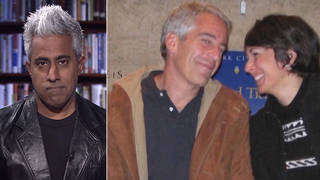
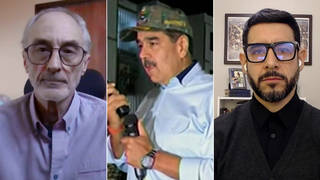
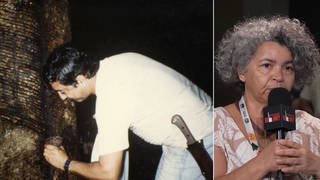
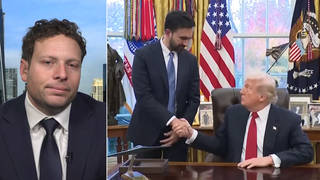





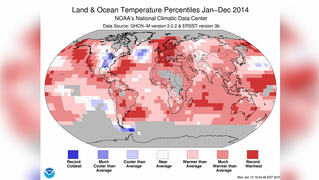
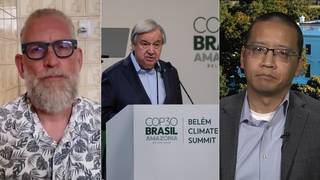
Media Options